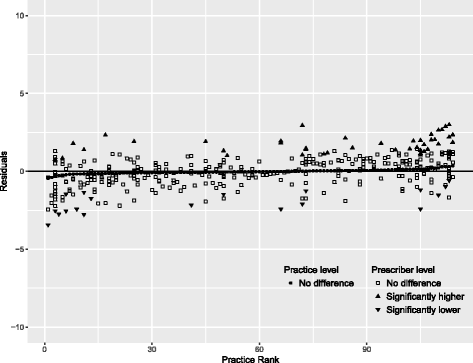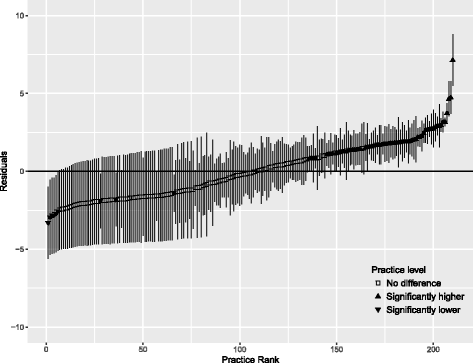Variation of polypharmacy in older primary care attenders occurs at prescriber level
- PMID: 29471806
- PMCID: PMC5824493
- DOI: 10.1186/s12877-018-0750-2
Variation of polypharmacy in older primary care attenders occurs at prescriber level
Abstract
Background: Polypharmacy is particularly important in older persons as they are more likely to experience adverse events compared to the rest of the population. Despite the relevance, there is a lack of studies on the possible association of patient, prescriber and practice characteristics with polypharmacy. Thus, the aim of this study was to determine the rate of polypharmacy among older persons attending public and private primary care clinics, and its association with patient, prescriber and practice characteristics.
Methods: We used data from The National Medical Care Survey (NMCS), a national cross-sectional survey of patients' visits to primary care clinics in Malaysia. A weighted total of 22,832 encounters of patients aged ≥65 years were analysed. Polypharmacy was defined as concomitant use of five medications and above. Multilevel logistic regression was performed to examine the association of polypharmacy with patient, prescriber and practice characteristics.
Results: A total of 20.3% of the older primary care attenders experienced polypharmacy (26.7%% in public and 11.0% in private practice). The adjusted odds ratio (OR) of polypharmacy were 6.37 times greater in public practices. Polypharmacy was associated with patients of female gender (OR 1.49), primary education level (OR 1.61) and multimorbidity (OR 14.21). The variation in rate of polypharmacy was mainly found at prescriber level.
Conclusion: Polypharmacy is common among older persons visiting primary care practices. Given the possible adverse outcomes, interventions to reduce the burden of polypharmacy are best to be directed at individual prescribers.
Keywords: Epidemiology; Medication; Multilevel modelling; Multimorbidity.
Conflict of interest statement
Ethics approval and consent to participate
Ethics approval for this study was granted by the Medical Research and Ethics Committee of the Ministry of Health Malaysia (NMRR-09-842-4718). All records were anonymised before use in the analysis.
Consent for publication
Not applicable.
Competing interests
The authors declare that they have no competing interests.
Publisher’s Note
Springer Nature remains neutral with regard to jurisdictional claims in published maps and institutional affiliations.
Figures



Similar articles
-
Association of potentially inappropriate medication use with patient and prescriber characteristics in Medicare Part D.Pharmacoepidemiol Drug Saf. 2013 Jul;22(7):728-34. doi: 10.1002/pds.3431. Epub 2013 Mar 14. Pharmacoepidemiol Drug Saf. 2013. PMID: 23494811 Free PMC article.
-
High-risk prescribing in an Irish primary care population: trends and variation.Br J Clin Pharmacol. 2017 Dec;83(12):2821-2830. doi: 10.1111/bcp.13373. Epub 2017 Aug 16. Br J Clin Pharmacol. 2017. PMID: 28701029 Free PMC article.
-
Inter-practice variation in polypharmacy prevalence amongst older patients in primary care.Pharmacoepidemiol Drug Saf. 2016 Sep;25(9):1033-41. doi: 10.1002/pds.4016. Epub 2016 May 2. Pharmacoepidemiol Drug Saf. 2016. PMID: 27133740
-
A systematic review of general practice-based pharmacists' services to optimize medicines management in older people with multimorbidity and polypharmacy.Fam Pract. 2021 Jul 28;38(4):509-523. doi: 10.1093/fampra/cmaa146. Fam Pract. 2021. PMID: 33506870
-
Evidence supporting the best clinical management of patients with multimorbidity and polypharmacy: a systematic guideline review and expert consensus.J Intern Med. 2019 Mar;285(3):272-288. doi: 10.1111/joim.12842. Epub 2018 Dec 10. J Intern Med. 2019. PMID: 30357955
Cited by
-
Prevalence of Drug-Related Problems and Complementary and Alternative Medicine Use in Malaysia: A Systematic Review and Meta-Analysis of 37,249 Older Adults.Pharmaceuticals (Basel). 2021 Feb 25;14(3):187. doi: 10.3390/ph14030187. Pharmaceuticals (Basel). 2021. PMID: 33669084 Free PMC article.
-
Influence of Education Level of Older Patients on Polypharmacy, Potentially Inappropriate Medications Listed in Beer's Criteria, and Unplanned Hospitalization: A Cross-Sectional Study in Lahore, Pakistan.Medicina (Kaunas). 2018 Aug 24;54(4):57. doi: 10.3390/medicina54040057. Medicina (Kaunas). 2018. PMID: 30344288 Free PMC article.
-
Are there socioeconomic inequalities in polypharmacy among older people? A systematic review and meta-analysis.BMC Geriatr. 2023 Mar 18;23(1):149. doi: 10.1186/s12877-023-03835-z. BMC Geriatr. 2023. PMID: 36934249 Free PMC article.
-
The Double Burden of the COVID-19 Pandemic and Polypharmacy on Geriatric Population - Public Health Implications.Ther Clin Risk Manag. 2020 Oct 20;16:1007-1022. doi: 10.2147/TCRM.S272908. eCollection 2020. Ther Clin Risk Manag. 2020. PMID: 33116550 Free PMC article. Review.
-
Prevalence of polypharmacy in the older adult population within primary care in Portugal: a nationwide cross-sectional study.Arch Med Sci. 2020 Mar 9;20(4):1118-1127. doi: 10.5114/aoms.2020.93537. eCollection 2024. Arch Med Sci. 2020. PMID: 39439699 Free PMC article.
References
-
- Statens institut för folkhälsan (Sweden). Healthy ageing: a challenge for Europe. Sweden, Stockholm: National Institute of Public Health; 2007.
-
- Centers for Disease Control and Prevention and The Merck Institute of Aging & Health. The State of Aging and Health in America. 2004:2004. https://www.cdc.gov/aging/pdf/state_of_aging_and_health_in_america_2004.pdf. Accessed 14 Jun 2016
Publication types
MeSH terms
Grants and funding
LinkOut - more resources
Full Text Sources
Other Literature Sources

